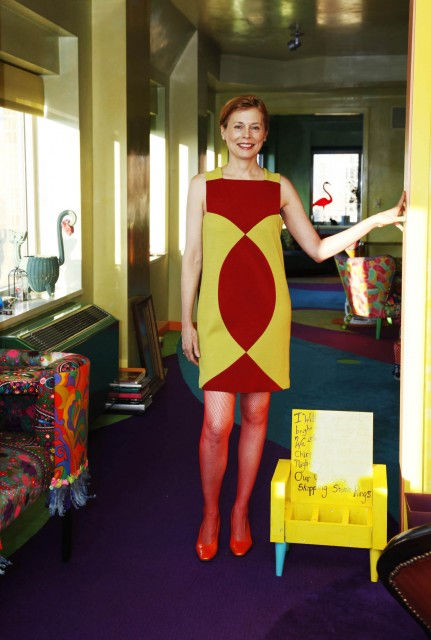Apryl Miller: Finding Creative Energy with Exuberant Colors in Manhattan
- TheSwishCompany

- Aug 2, 2019
- 3 min read
Updated: Dec 2, 2022
Last fall, I had the honor to sit down with a woman whose artistic home has been called, “one of the most immersive, intricate vibrant, and inhabitable art installations in the [New York] city” by the NYC online arts magazine, Hyperallergic.
Her artistic designs have been the background for Saks Fifth Avenue, Neiman Marcus and Glamour Magazine. Netflix has even featured her on their show, “Amazing Interiors” and you might also find her on various HGTV shows. Her blog, Zeitgeist, is a conglomeration of her creations and inspirations.

When I met Apryl on a blustery day over seafood in the heart of Manhattan, I was first intrigued by her accessories. Her necklace, which she told me was one of her original designs, was a myriad of shapes, textures, materials and colors all strung together in an unexpected pattern. Over her orange and black striped sweater, she wore a trench coat with Jetson’s characters marvelously painted on. Apryl’s creativity overflowed into her fashion and it was evident from the moment I met her.
In a booth in the back of the cozy Manhattan restaurant, I asked Apryl about her inspiration. She smiled and recalled her parents. She told me how her father was a minister, and watching both her parents work hard in helping professions has always motivated her. Her family had a very “Do-It-Yourself” mentality which instilled the concept of “making” deeply within her. She told me how in junior high, she dreamed of going to the Fashion Institute of Technology and at that young age taught herself to sew in order to fulfill that dream. Her hard work paid off and she attended FIT where she learned less about what rules to abide by in fashion and more about how she could break them. She also defined her working definition of creativity as, “endless freedom, no rules, and basically the wild wild West”.
So what else did Apryl learn at FIT that she’s carried with her to this day? She told me that she’s learned to find the line between people and art, then strip away the boundaries between the two. She is fascinated by asymmetry. “Symmetry is expected”, she explained. “There is an energy that comes with the unexpected in asymmetry, and I like that”.
These principles of boundary-breaking and asymmetry were the bedrock for her famous abode’s interior design where many photoshoots have taken place. We discussed the creative process behind it, and I learned a new perspective which she holds about colors. The colors in her art pieces are exuberant, overflowing and vibrant. This is opposite to my usual approach to fashion and decor - I often lean toward much more muted, pastel shades. Apryl advised me, however, that the more colors and patterns in a room, the more it seems to work. She feels that excessive colors don’t restrict the others, but rather they bring out the energy in one other. She explained to me how each color is usually tied to an emotion - like how black is judicious and means danger to her. She uses these energies as a basis of selection in her pieces, hoping that, “people should be able to have an understanding of the emotion without an explanation".

Our conversation about the emotion of colors quickly turned to the obvious question: is there such a thing as bad art? Apryl agreed with me that art can be created poorly. Although art is determined good or bad by the feeling it incites, it is not only based on that, she told me. Art history classes were pivotal for her, because she was able to learn about all the styles that had come before. She hopes for everyone to have access to art history, despite our busy modern lives, because of its impact. By studying art, the thought, intention and time put into quality designs rise to the surface. Apryl's interior design takes inspiration from past artistic styles, as described by Sak's Fifth Avenue Blog writer Alex Patino, "[her design] has a touch of 1950's Googie Architecture and hints of Schiaparelli bombast".

In my time with Apryl, I began to see creativity in a whole new way. We often strive to be “creative” within bounds we have created for ourselves. Although that isn’t necessarily wrong, it is good to get out of our boxes, out of our heads, and try something new. Apryl is a walking breathing model of creativity—she is her own art piece. Through Apryl I was able to recognize that creative environments breed inspiration and help us see the world in a whole different light.
How can you be more creative today?



_edited.png)

















Comments